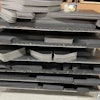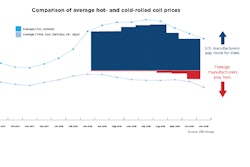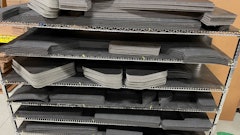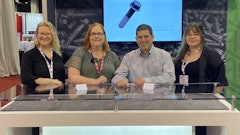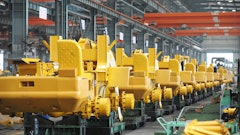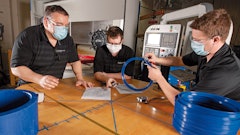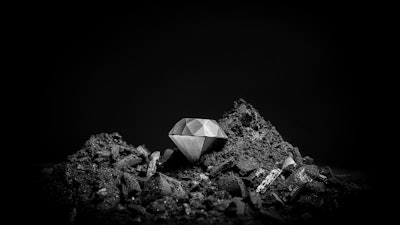
Sandvik Additive Manufacturing has created the first ever 3D printed diamond composite. While this diamond does not sparkle, it is perfect for a wide range of industrial uses. The new process means that this super-hard material can now be 3D printed in highly complex shapes and can thereby revolutionize the way industry uses the hardest natural material on the planet.
The diamond composite was unveiled at the RAPID + TCT show in Detroit May 21-23, 2019, North America’s leading event for Additive Manufacturing.
Diamond is harder than anything else in nature. It is a key component in a large range of wear resistant tools in industry, from mining and drilling to machining and also medical implants. Since 1953 it has been possible to produce synthetic diamond, but since it’s so hard and complicated to machine, it is almost impossible to form complex shapes.
Until now, production of super hard diamond materials only has allowed for a few simple geometric configurations to be formed. By using additive manufacturing and a tailor-made, proprietary post-processing method, Sandvik has managed to 3D print diamond composites which can be formed into almost any shape.
The difference between Sandvik’s diamond and natural or synthetic diamond is that Sandvik’s is a composite material. Most of the material is diamond, but to make it printable and dense it needs to be cemented in a very hard matrix material, keeping the most important physical properties of pure diamond.
The opportunities are enormous
Due to Sandvik’s use of additive manufacturing, diamond components can now be created application ready, in very complex shapes, without the need for further machining. This will open up the possibility of using it in applications that were previously considered impossible.
“Historically, 3D printing in diamond was something that none of us imagined was achievable,” explains Anders Ohlsson, Delivery Manager at Sandvik Additive Manufacturing. “Even now we are just starting to grasp the possibilities and applications that this breakthrough could have.
“On seeing its potential, we began to wonder what else would be possible from 3D printing complex shapes in a material that is three times stiffer than steel, with heat conductivity higher than copper, the thermal expansion close to Invar – and with a density close to aluminium. These benefits make us believe that you will see this diamond composite in new advanced industrial applications ranging from wear parts to space programs, in just a few years from now.”
The company says that since it is a completely new innovation and material that has not existed before, it is difficult to predict all possible applications in each industry. It predicts it will be used in many different industries where there is a need for wear resistance, extremely durable parts, efficient cooling and complex shapes, such as for internal coolant channels, advanced nozzles or brackets. Sandvik says it is certain its customers will find relevant applications based on their expertise and needs.
In general, the company says the properties of the diamond material makes it suitable for parts subject to high wear—which can be found in basically any industry—as the hardness of the diamond will make the parts last longer.
Another noted general application is the use as a heat sink i.e. to extract heat away from hot, sensitive components such as electronics.
The lighter density of the material also makes it a potential material of interest for those applications where weight may be a concern. Diamond is today already used in many industrial applications including mining, Sandvik also notes. 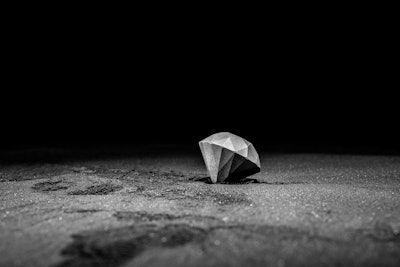
The 3D printing process
“The additive manufacturing process used is highly advanced,” explains Mikael Schuisky, Head of R&D and Operations at Sandvik Additive Manufacturing. “We are printing in a slurry consisting of diamond powder and polymer using a method called stereolithography, where complex parts are produced, layer by layer, using ultraviolet light. The step after the 3D printing is however even more demanding. This is where Sandvik has developed a tailor-made, proprietary post processing method making it possible to achieve the exact properties of the super-hard diamond composite.
“This step was extremely complicated. However, after extensive R&D efforts and several trials we managed to take control over the process and made the first 3D printed diamond composite.”
“It was incredible to see what we can achieve when we combine Sandvik’s leading expertise in materials technology with our strong capabilities in additive manufacturing and post processing,” comments Schuisky. “We have some of the world’s leading experts in both materials and additive manufacturing, which in a case like this can benefit many industries around the globe making it possible to use diamond in applications and shapes never conceived possible before.”
“Rather than looking to actually develop completely new materials, today the big push within the industry involves the often-radical restructuring of existing materials,” says Annika Borgenstam, Professor at the Department of Materials Science and Engineering at Stockholm’s KTH Royal Institute of Technology.
“Using revolutionary new processes such as additive manufacturing will open up completely new ways of using the same types of materials that we have today, by building in the properties that we need.”
“Sandvik’s 3D printed diamond composite is a true innovation. It means that we can begin to use diamond in applications and shapes never conceived possible before,” says Susanne Norgren, Adjunct Professor in Applied Materials Science at Uppsala University. “Just imagine what it could do to industries, when it is possible to print anything, in any shape – in diamond.”
Sustainable with superior properties
Another key advantage of additive manufacturing is that it allows engineers to minimize material waste, making the technology more sustainable. The diamond powder in Sandvik’s process can be extracted from the polymer in the slurry after the printing, and then be recycled and reused in another print-job.
The diamond composite has been tested and found to have extremely high hardness, exceptional heat conductivity, while also possessing low density, very good thermal expansion and fantastic corrosion resistance.
“We now have the ability to create strong diamond composites in very complex shapes through additive manufacturing, which fundamentally will change the way industries will be able to use this material. As of now, the only limit to how this super-hard material can be shaped and used is down to the designer’s imagination,” Schuisky concludes.


